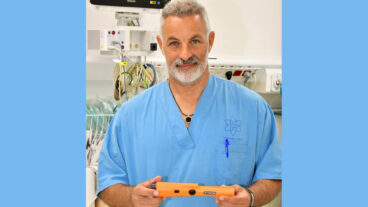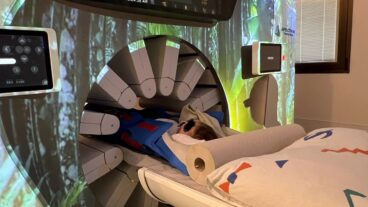A figure of the antibiotic gentamicin bound to its RNA target – the Israeli study has shown that gentamicin allows chloride to be escorted effortlessly in and out of cells.Israeli researchers have found that an antibiotic used for years against common infections may have the remarkable ability to correct a genetic flaw in cystic fibrosis, a finding that ultimately may lead to a new way of treating that and other intractable genetic diseases.
Their findings, published recently in the New England Journal of Medicine, could be applied to other genetic disorders, including muscular dystrophy, Hurler’s syndrome, and various types of hemophilia and cancer, say Dr. Michael Wilschanski and Prof. Eitan Kerem, who headed the team.
Experts in the field have called their accomplishment a “major breakthrough” in the treatment of CF.
Cystic fibrosis occurs mostly in whites and strikes one in every 3,200 live Caucasian births in this country, and 1,000 new cases are diagnosed annually, according to statistics from the Cystic Fibrosis Foundation. An estimated 30,000 children and adults in the United States are afflicted and have an average life expectancy of 33.4 years. There are some 500 Israelis diagnosed with CF.
The researchers have managed to repair a form of the mutant gene that causes the inherited lung disease cystic fibrosis (CF) with antibiotic nasal drops commonly used for eye infections called Gentamicin. The antibiotic, long a staple in the fight against bacteria, has the unusual ability to override a major genetic defect in cystic fibrosis and tweak DNA transcription involved in the entrance and exit of chloride in cells.
Just as a memo must be transcribed for dispersal to workers, something similar must occur in the transcription of messages from DNA, the master text of life. Messages contained within DNA must be read and then transcribed by the cellular stenographer, RNA, before a key protein involved in proper chloride activity can be made. People with cystic fibrosis have specific DNA mutations, garbling instructions for production of the protein that chaperones chloride through channels.
The Israeli study has shown that gentamicin corrects the nonsense, allowing chloride to be escorted effortlessly in and out of cells. Wilschanski and Kerem, conducted most of their work at Sha’are Zedek Hospital, studying 19 children with well-defined miscues in a gene dubbed CFTR (cystic fibrosis transmembrane conductance regulator).
“Our study is preliminary, and it’s just on the nose, bear in mind,” Wilschanski told ISRAEL21c. “At this point we couldn’t try it on the lungs, as there could be lots of side effects. So we used the nose as a living laboratory. We had a whole bunch of volunteers from around the country. They were tested, given the drops to use for two weeks, tested again, given another set of drops for two weeks, and then tested a third time.”
That administering the antibiotic as nose drops – two drops given three times daily for 14 days – corrected the genetic flaw, but only in cells lining nasal tissue. The CFTR function was restored and the electro-physiological abnormalities were corrected. Their next step is to test gentamicin’s ability to affect pulmonary function.
About 1,000 different types of CFTR miscues have been identified. The type defined by Wilchanski, called a “stop mutation,” affects a majority of people with cystic fibrosis in Israel
“Genetic mistakes are very specific for communities. In Israel, there’s a very specific type of genetic mistake in CF patients — the ‘stop mutation’ — which is found in about 60% of Israelis who have CF. That’s compared to 5% worldwide who have the stop mutation,”said Wilschanski, who immigrated to the Gush Etzion town of Elazar from London in 1985 and was recently named the head of the pediatric gastroenterology department at Hadassah Hospital Ein Kerem.
Another type, known as delta-508, is more commonly diagnosed in the United States, Europe and Canada. But regardless of the mutation, disease manifestations are the same.
The team had completed a smaller but successful pilot study on only nine patients nearly four years ago; this was the first time that researchers were able to cause the repair of a genetic mutation that causes CF. But the current study is larger and, more persuasively, a randomized, double-blind controlled study, according to health reporter Judy Siegel of The Jerusalem Post.
CF is a potentially fatal disease in which the lungs get clogged with mucous, causing severe infections. The only definitive treatment is a lung transplant, but because donor organs are rare, most patients have no alternative but to swallow many pills of different antibiotics and pancreatic protein supplements each day, eat a special high-calorie diet, and undergo intensive physiotherapy to break up the mucous. Many different CFTR mutations can cause CF, and only a small percentage has the STOP mutations that would respond to aminoglycoside treatment.
In genetic diseases, mutations disrupt or completely prevent the production of proteins in the cell that are vital for the proper functioning of body systems. The STOP mutations give an erroneous order to halt the production of the protein. The nasal drops caused the appearance of the protein, which previously was not produced in the patients’ cells; the protein caused chloride ions and water to be released from the cell and the mucous to be washed out of the nose. The implication is that if the same drug can be administered to clogged mucous membranes deep inside the body, their cells would normalize as well.
The work by the researchers promises a way of controlling the disease, but probably not curing it, doctors say. Moreover, the drug likely will be effective only against the type of mutation predominantly seen among people of Ashkenazi Jewish descent. Yet developing gentamicin as a therapy remains years away.
“We’re at the beginning, and we have a long way to go. But it’s a novel way of looking at genetic disease, and it’s also applicable to other diseases as well,” said Wilschanski. “It holds hope for this group of patients in a few years time. Giving to babies right off a diagnosis, there’s a good chance of avoiding global symptoms.”
“The bottom line here is not to think of gentamicin as an antibiotic,” Dr. Peter Durie, director of the Cystic Fibrosis Center at the Hospital for Sick Children in Toronto, told Newsday. “Its role in this study has nothing to do with [treating] infection.”
Durie, an expert on cystic fibrosis who was not associated with the experiments, said the discovery opens a window on research, demonstrating that a well-known drug may have the power to influence genes. “The idea behind this paper is that this concept can be used in other genetic diseases,” he said.
“This is a very important proof of principle,” Dr. Robert Beall, president of the Cystic Fibrosis Foundation in Bethesda, Md., said of the Israeli findings. “There is still a long way to go,” he added, to show that gentamicin can correct the anomaly in the lungs.
Beall told Newsday that other disorders, such as Duchenne’s muscular dystrophy and Hurler’s syndrome, also may respond to correction by a member of the antibiotic family to which gentamicin belongs.












